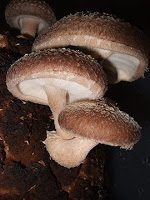 |
| shiitake mushrooms |
Sayer Ji, Contributing Writer
Activist Post
Over the course of the past few years we have uncovered a remarkable body of research on the medicinal properties of mushrooms.
In fact, when it comes to natural cancer research, no other category has been the subject of more human clinical research than AHCC and Lentinan, both unique preparations of shiitake mushroom.
AHCC stands for active hexose correlated compound, and is classified as a functional food made from hybridized mycelia of shiitake (and sometimes other mushrooms) in rice bran. It contains both alpha- and beta-glucan polysaccharides, well-known modulators of host immunity. Lentinan, also from shiitake (Lentinula edodes), is exclusively beta-glucan. What is so unique about these compounds is that they are “host-mediated” anti-cancer agents, helping the cancer-afflicted body combat cancer by boosting immune function.
This is a radically different approach versus conventional chemotherapy, which poisons rapidly dividing cells, indiscriminately, killing both cancer and immune cells (among other healthy cell types).
How can edible mushrooms like shiitake protect us against cancer, perhaps the most widely feared disease that presently afflicts our species? Could the reason be that we co-evolved with fungi, and that the essential polysaccharides they contain were present in our diet for so long that the genetic/epigenetic infrastructure of our bodies now depends on them? Beta-glucan, after all, is found widely distributed in whole grains, nutritional yeast, as well as fungi. The friendly bacteria, in and outside of our gut, produce the beta-glucan fraction through the biotransformative processes of digestive fermentation and, in the case of food, culturing. Could it be that, failing to consume (or produce) adequate quantities, our body fails in its cancer immunosurveillance — not unlike the well-established role that vitamin D deficiency has in maintaining proper immune function, and therefore reducing cancer risk.
But perhaps there is an even deeper reason to why fungi keep us alive and well, even when faced with the most terrible of health challenges: we share a common, unique evolutionary origin, and our fates may still be intimately interwoven.
The microbiologist Mitchell Sogin was interviewed back in 2004 on the topic:
‘Animals and sponges share a common evolutionary history from fungi…
Declare Your Independence!Profit outside the rigged system! Protect yourself from tyranny and economic collapse. Learn to live free and spread peace!#mc_embed_signup {clear:left; font:14px Helvetica,Arial,sans-serif; text-align: center; padding-bottom: 15px; } .cmhead{color: rgb(255,199,27); text-shadow: 1px 1px 3px rgba(0,0,0,0.5); text-align: center; font-size: 250%; font-family: sans-serif; font-weight: 700;} .cmsubhead{color: rgb(255,255,255); text-align: center; font-size: 150%; font-family: sans-serif;} .cmformhead{color: rgb(30, 29, 29); font-size: 160%; font-family: sans-serif; margin-bottom: 10px;} #mc_embed_signup form { display: inline-block; background-color: #FFF; background-color: #FFF; margin-top: 20px; border-color: rgb(31, 31, 31); outline: none; background-color: rgb(255, 255, 255); opacity: 1; border-width: 3px; border-style: solid; border-radius: 5px; width:70%; } #mc_embed_signup input.email {width: 90%; } #mc_embed_signup input.button { width: 93%; background-color: rgb(246, 137, 34); border-bottom: 3px solid rgba(0,0,0,0.2); font-size: 160%;} #mc_embed_signup .button:hover {background-color: #e67409;} /* Add your own MailChimp form style overrides in your site stylesheet or in this style block. We recommend moving this block and the preceding CSS link to the HEAD of your HTML file. */
Counter Markets Newsletter - Trends & Strategies for Maximum FreedomClaim Your FREE Issue Today!…we thought fungi were related to plants or somehow were just colorless plants. Plants had seeds, fungi had spores, and so on. Scientists used to publish fungi articles in plant journals. But the work does not support that. We’ve shown that fungi and plants are very different from each other, and fungi are actually more closely related to animals.’
When asked the question: “Does all this mean humans are just highly evolved mushrooms?” Sogrin answered:
I’d say we share a common, unique evolutionary history with fungi. There was a single ancestral group of organisms, and some split off to become fungi and some split off to become animals.’
Could medicinal/edible mushrooms “lend us their power”? In certain traditions of herbalism, there is an acknowledgment of the sacred bond between patient and herb, where the plant lends its power to (s)he who is suffering, as a “plant ally.” Beyond nutritional and caloric content, biochemical make-up, pharmacology, etc., certain fungi may embody the biological equivalent of compassion, and exude an abundance or superfluity of life energy that we may harness to correct imbalances within ourselves.
First, we must be willing to acknowledge that power in a source outside of ourselves, which is difficult for egocentric, anthropocentric humans to do. Second, we must consider ourselves worthy of the miracle of being healed, of life regenerating itself through us.
To learn more about the sacred bond between fungi and humanity, as well as how “mushrooms may save the world,” please watch Paul Stamet’s amazing video on the topic below…
Please visit GreenMedInfo to access their vast database of articles and the latest information in natural health.
linkwithin_text=’Related Articles:’


